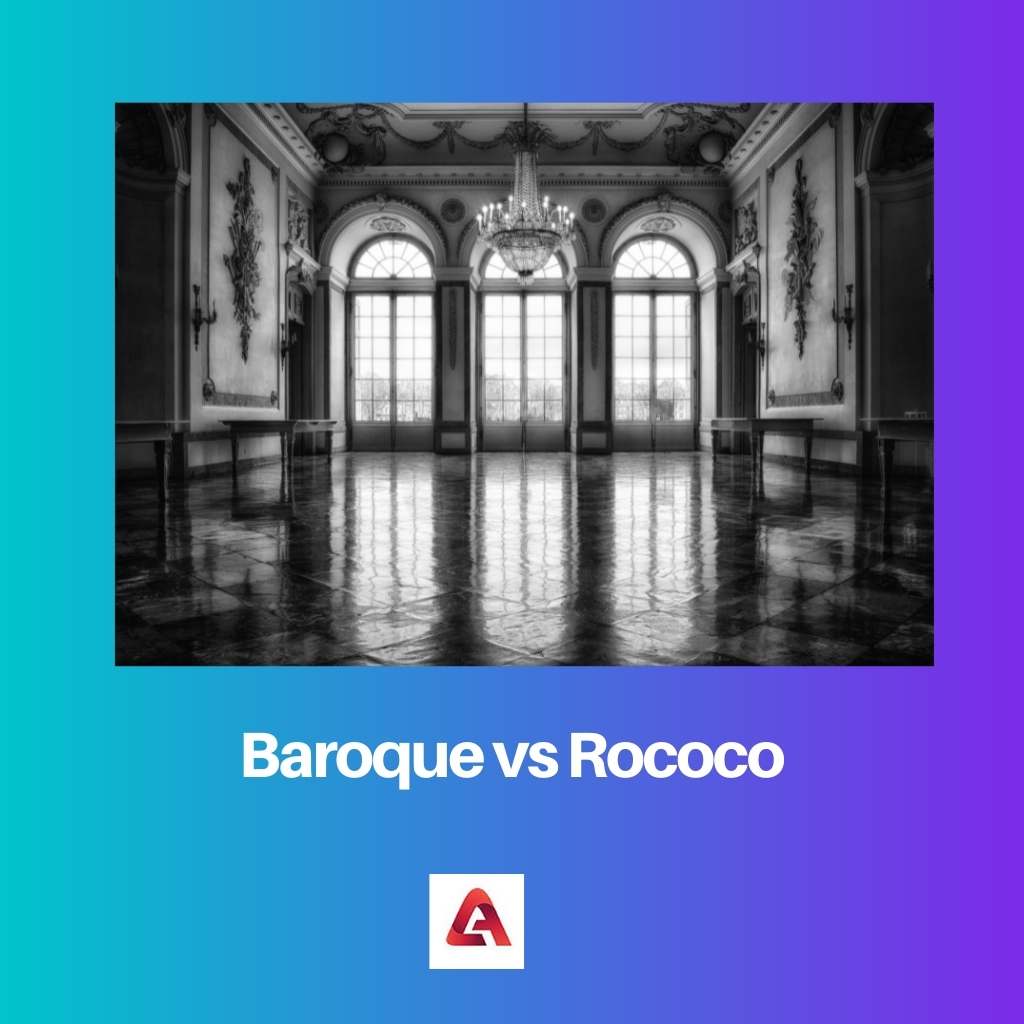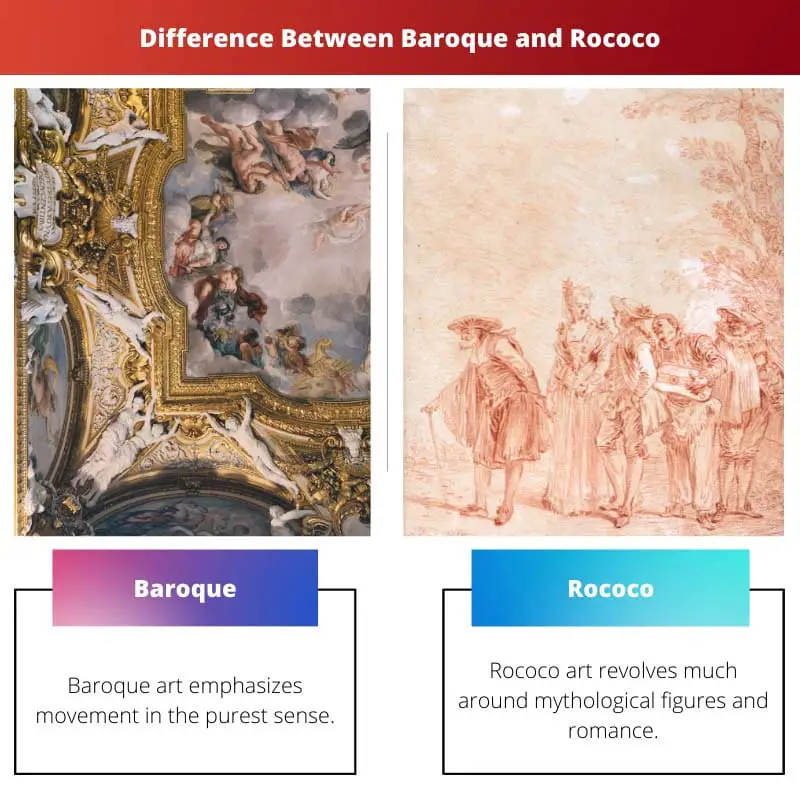Art is considered to be the most serene form of human expression. As far as the historical artefacts are concerned, they are living examples of the fact that designing living areas has been prevalent since time immemorial.
The different types of art forms have their respective significance, and interested people hold even the minutest pieces in high spirits.
Key Takeaways
- Baroque art and architecture emphasize grandeur, bold colors, and dramatic contrast, while the Rococo style is lighter, more delicate, and ornate.
- Baroque originated in Italy in the early 17th century, while Rococo emerged in France in the early 18th century.
- Baroque works have religious and political themes, while Rococo focuses on leisure, love, and nature themes.
Baroque vs Rococo
The difference between Baroque and Rococo is that the former uses symmetrical designs while the latter is more asymmetrical and feminine in structure. It is considered that Rococo is the advanced version of Baroque. They coexisted after Rococo came in its full swing. Presently, only the historical remains exist.

Baroque was more of a movement than an art form. As per historians, art dominated those times so much that the whole movement came to be known by its name.
The common populace of Europe boasted of the items made in the Baroque style. The pieces were quite delicate and could cost a fortune.
Rococo flourished mainly in France. The lovers of the Baroque style soon shifted to this art form. Though the styles were different, the lavish appeal made the French people collect all they could.
Once a Rococo-style scripture was mounted in a public place, the visitors could not simply take their eyes off it.
Comparison Table
| Parameters of Comparison | Baroque | Rococo |
|---|---|---|
| Painting Style | Baroque art emphasizes movement in the purest sense. | Rococo art revolves much around mythological figures and romance. |
| Main Artists | Pietro da Cortano, a trompe l’oeil, and Peter Paul Rubens propagated Baroque in the beginning. | Francois Boucher and Giambattista Tiepolo were the prominent figures of Rococo art. |
| Time of Existence | 15th century | 17th century |
| Shades Used in Major Artworks | Contrasting shades were blended in the authentic pieces of Baroque artwork. | Pastel shades and floral inputs were the fundamentals of Rococo. |
| Style of Furniture Carvings | A lot of curves were used in Baroque furniture pieces. | Elegance and golden hues were added to most Rococo furniture. |
What is Baroque?
Baroque means imperfection in Latin. Some sources also suggest that this word has been derived from the etymological roots of pearl, symbolizing the protruding appearance of most figures and figurines.
The feminine approach made this art form more complicated, but the apt detailing attracted art lovers worldwide. As far as the ongoing movement is concerned, the events have been linked to the Protestant movement.
Baroque has its roots in Europe. Since their culture was predominated by style and artefacts, the Baroque artists lived well.
Most of the artists were of a Catholic viewpoint, and sociologists are of the opinion that their views were expressed indirectly through these intricate paintings.
The depiction of movement is metaphorically displayed as the movement of thought. During Renaissance, people felt that the thought process was going through a leap.
Baroque artists were known for creating rough sketches before blending in the colours. A final touch was given by adding additional curves to facilitate the emphasis of movement.
Some of the popular structures of elite significance include Aeneas Flees Burning Troy and the main altar of St. John’s Co-Cathedral. They were so dark that people thought that the concept of brightness was faded in those times.

What is Rococo?
Rococo has its roots in France. This art form had many decorative pieces with a lot of added lustre. The usage of golden color is the main characteristic of Rococo art.
The artists wished to depict how the people tried to complement their lives with extra resources as revolutions were taking place. Despite the prevalent darkness, the brighter side was visible.
These paintings and furniture pieces imbibed a lot of positivity. Rococo art radiated romance in its purest form. Though no named figures have been incorporated into the list, artists preferred to draw their fictional romantic figures as per the circumstances of those times.
Though colors were aptly used, the blending of browns and matte shades of red make it all look much more intriguing. Flowers are also one of the central themes of Rococo art.
These inclusions made the figures less intense and metaphorical, though each painting told a story.
Rococo can be considered as a subset of the Baroque movement in simpler terms. In a Venn diagram, if Baroque is a bigger circle, Rococo is a smaller circle existing inside the bigger circle.
The royal people still consider it a luxury to incorporate such Renaissance period arts in lavish places.

Main Differences Between Baroque And Rococo
- Baroque’s painting style incorporates the depiction of movement in the most contemporary form. On the other hand, Rococo lays much emphasis on romantic moments and the mythology of those times.
- The prominent figures of the Baroque segment were Pietro da Cortano, a trompe l’oeil, and Peter Paul Rubens. Francois Boucher and Giambattista Tiepolo acted as the torchbearers for the Rococo style of art.
- Baroque was at its peak around the 15th century, while Rococo flourished during the later years of the 17th century.
- As far as the color implementation is concerned, Baroque used only contrasting shades in blended form. On the contrary, Rococo was a non-blended mode with pastel shades and a tinge of gold.
- Baroque predominated mostly with curved designs in the furniture embellishments, whereas Rococo kept it simple with a brilliant elegance of shimmer.


The contrast between Baroque and Rococo art is articulated with meticulous detail. The mention of contrasting shades in Baroque and the pastel shades in Rococo offers a clear distinction between the two styles.
The article skillfully presents the key differences between Baroque and Rococo art, providing a thorough analysis of their artistic styles, themes, and historical contexts. The comparison table is particularly useful in highlighting these distinctions.
The article effectively captures the essence of Baroque and Rococo art. The insights into the main artists of each movement and the artistic themes bring a depth of understanding to the readers.
Indeed, the illumination on the main artists and the thematic focus of Baroque and Rococo art is highly informative. It offers a nuanced perspective on the significance of these art forms.
This article provides a comprehensive and enlightening explanation of Baroque and Rococo art. The historical significance of these art forms in Italy and France is very well explained. The detailed comparison table is particularly helpful in understanding the key differences between the two styles.
Absolutely, the article does a great job in presenting the characteristics and evolution of Baroque and Rococo art. The emphasis on both religious and leisure themes in the respective styles adds depth to the understanding of their cultural significance.
I concur. The reference to the prominent artists of Baroque and Rococo art is quite enlightening. It offers a glimpse into the individuals who played pivotal roles in shaping these art movements.
The discussion of the prominent figures of Baroque and Rococo art provides valuable insights into the key contributors to these artistic movements. It’s fascinating to learn about the artistic styles and themes of both periods.
The detailed explanation about Baroque and Rococo art is indeed enlightening. The comparison table effectively captures the key differences between the two art forms, shedding light on their unique characteristics and styles.
Absolutely, the article’s elucidation of Baroque and Rococo art provides a nuanced understanding of their distinct features and historical contexts.
I completely agree. The in-depth exploration of the historical roots and artistic elements of Baroque and Rococo art broadens one’s knowledge of these significant art forms.
The historical origins of Baroque and Rococo art in Italy and France, respectively, provide a rich context for understanding the development of these art forms. The artistic themes and styles are clearly presented and contrasted.
The article’s comprehensive coverage of Baroque and Rococo art offers a detailed understanding of their respective styles and historical significance. The in-depth exploration provides valuable insights into the development of these art movements.